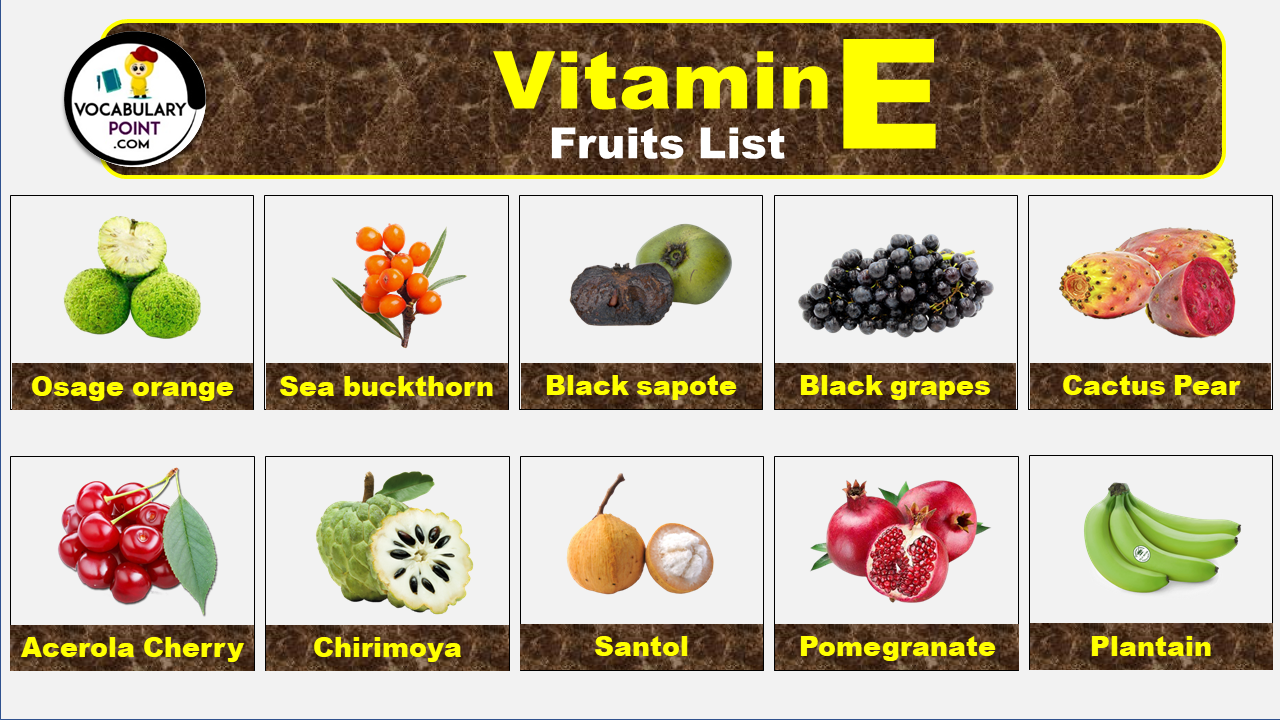Vitamin E is a powerful antioxidant that plays a crucial role in maintaining the health and vitality of our bodies. It helps protect our cells from damage caused by harmful free radicals, reduces inflammation, and promotes healthy skin and hair. While vitamin E supplements are readily available, one excellent way to ensure we get an adequate amount of this essential nutrient is by incorporating vitamin E-rich fruits into our diet.
List of Vitamin E Fruits
Hedge Apple
A green, bumpy fruit of the Osage orange tree, mainly ornamental and not commonly eaten. Known for its pest repellent properties.
Cashew Apple
The fleshy part of the cashew fruit, attached to the cashew nut. Juicy and sweet-tart, used in beverages and jams.
Prickly Pear
The fruit of the nopales cactus, known for its sweet, watermelon-like flavor. Eaten fresh or used in beverages.
Citron
A large, fragrant citrus fruit with a thick rind and very little pulp or juice. Used for its zest and in candied form.
Cornelian Cherry
A small, tart, red berry-like fruit from a species of dogwood. Used in jams, syrups, and traditional medicine.
Feijoa
A green, egg-shaped fruit with a sweet, aromatic flavor. The flesh is juicy and slightly tart, used in desserts and drinks.
Monstera Deliciosa
A tropical fruit with a pineapple-banana flavor, from the Monstera plant. Must ripen fully to avoid irritation from oxalic acid.
Horned Melon
Also known as Kiwano, characterized by its horn-like spikes and lime green, jelly-like interior. Tart and refreshing.
Blackberry Lily
The fruit resembles a blackberry but is actually the seed cluster of the Iris domestica plant, not commonly eaten.
Lychee
A small, tropical fruit with a sweet, fragrant flavor. Has a rough, red outer skin and a white, juicy interior.
Chirimoya
Also known as custard apple, a green, heart-shaped fruit with creamy, sweet flesh. High in vitamins and minerals.
Breadfruit
A large, starchy fruit, used cooked similar to potatoes. Versatile in culinary uses, from fried to boiled.
Kiwi
A small fruit with fuzzy, brown skin and bright green or yellow flesh. Sweet and tangy, rich in vitamins C and K.
Pomegranate
A fruit with a tough outer rind and sweet, juicy seeds inside. High in antioxidants and vitamins C and K.
Santol
A tropical fruit with a cotton-like texture inside, sweet and sour. Eaten fresh or used in Filipino cuisine.
Indian Gooseberry (Amla)
A sour, nutrient-rich berry used in Ayurvedic medicine and as a health supplement.
Pineapple
A tropical fruit with a rough, spiky exterior and sweet, juicy interior. Rich in vitamins, enzymes, and antioxidants.
Blackcurrant
A small, tart berry rich in vitamins C and A, potassium, and antioxidants. Used in juices and jams.
Muntingia
A small, sweet fruit also known as Jamaican cherry or Panama berry. Eaten fresh or used in jams.
Jabuticaba
A unique Brazilian fruit that grows directly on the trunk of its tree. Sweet and grape-like in flavor.
Durian
A large, spiky fruit known for its pungent smell and creamy, custard-like flesh. Loved and loathed for its unique taste.
Blackberries
Juicy, dark berries known for their sweet and slightly tart flavor. Rich in vitamins C and K, and fiber.
Mulberries
Fruits of the mulberry tree, sweet and slightly tart, ranging in color from white to pink to black. Used in various cuisines.
Mangosteen
A tropical fruit with a thick, purple rind and sweet, juicy, white segments inside. Known as the “queen of fruits.”
Riberry
A small, red, cranberry-like fruit from Australia, with a tart, cranberry-like flavor. Used in sauces and jams.
Sea Buckthorn
A small, orange berry known for its high vitamin C content. Used in juices, oils, and nutritional supplements.
Acerola Cherry
A small, bright red fruit known for its high Vitamin C content. Grows on a shrub native to South America, Central America, and the Caribbean.
Salak
Also known as snake fruit, for its reddish-brown scaly skin. Sweet and acidic taste, with a crunchy texture.
Avocado
A creamy, green fruit rich in healthy fats, vitamins, and minerals. Used in both savory and sweet dishes.
Beach Plum
A small, wild plum found in coastal sand dunes in the Eastern United States. Used in jams and jellies.
Cupuacu
A tropical rainforest fruit related to cacao, with a creamy, exotic-tasting flesh. Used in desserts and beverages.
Papaya
A tropical fruit with orange flesh and black seeds. Sweet and rich in vitamins C and A.
Horseradish Tree (Drumstick)
The pods and leaves of the Moringa oleifera are used in cooking. High in nutrients and antioxidants.
Osage Orange
Fruit of the Osage orange tree, not commonly eaten, known for its large, green, brain-like appearance.
Plantain
A starchy, banana-like fruit consumed cooked rather than raw. Used in many tropical cuisines, often fried or boiled.
Saskatoon Berry
A small, dark purple fruit also known as saskatoon berries. Sweet, nutty flavor, used in pies and jams.
Star Apple
A tropical fruit with a purple or green skin and a star pattern when cut. Sweet, milky flesh, eaten fresh.
Passionfruit
A tropical fruit with a hard outer rind and juicy, seed-filled interior. Sweet and tart, rich in vitamins A and C.
Jackfruit
A large tropical fruit with a sweet taste and texture that can resemble meat when cooked. Rich in vitamin B6.
Ugli Fruit
A citrus fruit with a rough, green, and orange exterior. Sweet and tangy, a hybrid between a grapefruit, orange, and tangerine.
Tangerine
A small citrus fruit with a deep orange color, easier to peel than oranges. Sweet and less sour than oranges.
Apricot
A small, orange fruit with velvety skin and sweet, slightly tart flesh. High in vitamins A and C.
Cactus Pear
Also known as prickly pear, a fruit from the cactus plant, with a sweet, watermelon-like flavor. Eaten fresh or in beverages.
Cucumber
A long, green vegetable with a crisp texture and refreshing taste. Mostly eaten raw in salads, technically a fruit.
Longan
A tropical fruit related to the lychee, with a translucent flesh and sweet taste. Eaten fresh or dried.
Surinam Cherry
A small, red or black fruit with a tart flavor, grown in tropical regions. Used in jams and jellies.
Cranberry
Small, tart, red berries often used in sauces, juices, and dried snacks. Known for urinary tract health benefits.
Quince
A yellow fruit resembling a pear, used mainly cooked due to its hard, bitter raw state. Rich in pectin for jams and jellies.
Barberry
A small, tart, red berry used in Persian cuisine, known for its sour flavor. Rich in vitamin C.
Fig
Sweet fruits with a soft texture and multiple small seeds inside. High in fiber and minerals like magnesium and calcium.
Guava
A tropical fruit with green skin and pink or white flesh. Rich in dietary fiber, vitamin C, and lycopene.
Mango
A tropical fruit with a sweet, juicy pulp. Rich in vitamins A and C, and dietary fiber.
Raspberries
Small, red berries known for their sweet and slightly tart flavor. High in fiber, vitamins, and antioxidants.
Almonds
Not a fruit but the seed of the almond tree’s fruit. High in healthy fats, protein, and vitamin E.
Mamey Sapote
A tropical fruit with a rough brown skin and sweet, orange-red flesh. Rich in vitamins and minerals, eaten fresh or in desserts.
Yangmei
Also known as Chinese bayberry, a round, red fruit with a sweet and tart flavor. Eaten fresh or used in traditional Chinese medicine.
Boysenberries
A large, juicy berry with a deep maroon color, a cross among blackberry, raspberry, and loganberry. Sweet and tangy flavor.
Hazelnuts
Not a fruit but the nut of the hazel tree, rich in healthy fats, vitamins, and minerals. Used in confections and spreads.
Cloudberry
A rare, amber-colored berry found in cold, boggy regions. Sweet and tart, used in desserts and jams.
Black Sapote
A tropical fruit resembling a green tomato, with chocolate-pudding-like flesh. Sweet and custard-like, used in desserts.
Olive
A small fruit rich in healthy fats and antioxidants. Used for its oil and as a table fruit, both fresh and cured.
Medlar
An unusual fruit that must be bletted (overripened) to become edible. Tastes like spiced apple sauce when ripe.
Gooseberries
Small, sour, green fruits often used in desserts and jams. Rich in vitamin C and dietary fiber.
Pomelo
The largest citrus fruit, with a sweet and slightly tart taste. Thicker skin than grapefruits.
Persimmon
A sweet, slightly tangy fruit with a soft to firm texture. Rich in vitamins A and C.
Dragon Fruit
A bright pink or yellow fruit with white or red flesh dotted with black seeds. Mildly sweet, used in smoothies and salads.
Pistachios
Not a fruit but a seed of the pistachio tree, known for its rich, buttery flavor. High in healthy fats and protein.
Miracle Fruit
A berry that changes taste perceptions, making sour and bitter foods taste sweet. Used for flavor-tripping experiences.
Chayote
A green, pear-shaped vegetable also known as vegetable pear, eaten cooked or raw. Mild in flavor, used in salads and stews.
Nectarine
A smooth-skinned fruit similar to a peach but without the fuzz. Sweet with a slightly firmer texture.
Blueberries
Small, blue berries known for their sweet flavor and high antioxidant content. Used in various culinary dishes.
Cranberries
Small, tart, red berries often used in sauces, juices, and dried snacks. Known for urinary tract health benefits.
Elderberries
Small, dark berries known for their immune-boosting properties. Often used in syrups and jams.
Starfruit
A tropical fruit shaped like a star when sliced. Sweet and sour in taste, rich in vitamin C.
Marula
A fruit native to Africa, used in the production of Amarula liqueur. Sweet and tart, high in vitamin C.
Tamarillo
Also known as tree tomato, a fruit with a tangy flavor, used in cooking and sauces. Eaten fresh or cooked.
Kiwifruit
A small fruit with fuzzy, brown skin and bright green or yellow flesh. Sweet and tangy, rich in vitamins C and K.
Breadnut
Also known as Maya nut, a starchy fruit used like a vegetable or ground into flour. Nutty flavor, used in traditional dishes.
Black Grapes
Small, dark-colored grapes, sweeter and more flavorful than their green counterparts. Used in wines and as table grapes.
Mammee Apple
A tropical fruit with a rough brown skin and sweet, fragrant, orange flesh. Eaten fresh or used in desserts.
Sapodilla
A tropical fruit with a brown, fuzzy skin and sweet, pear-like flesh. High in vitamins and minerals.
Soursop
Also known as Guanabana, a large fruit with a spiky green exterior and soft, sweet interior. Used in beverages and desserts.
Ackee
A tropical fruit with a unique taste and texture, used in Jamaica’s national dish. Must be properly prepared to avoid toxicity.
Explore More Fruits Names:
Fat Rich Fruits | Hard Fruits | Brazilian Fruits
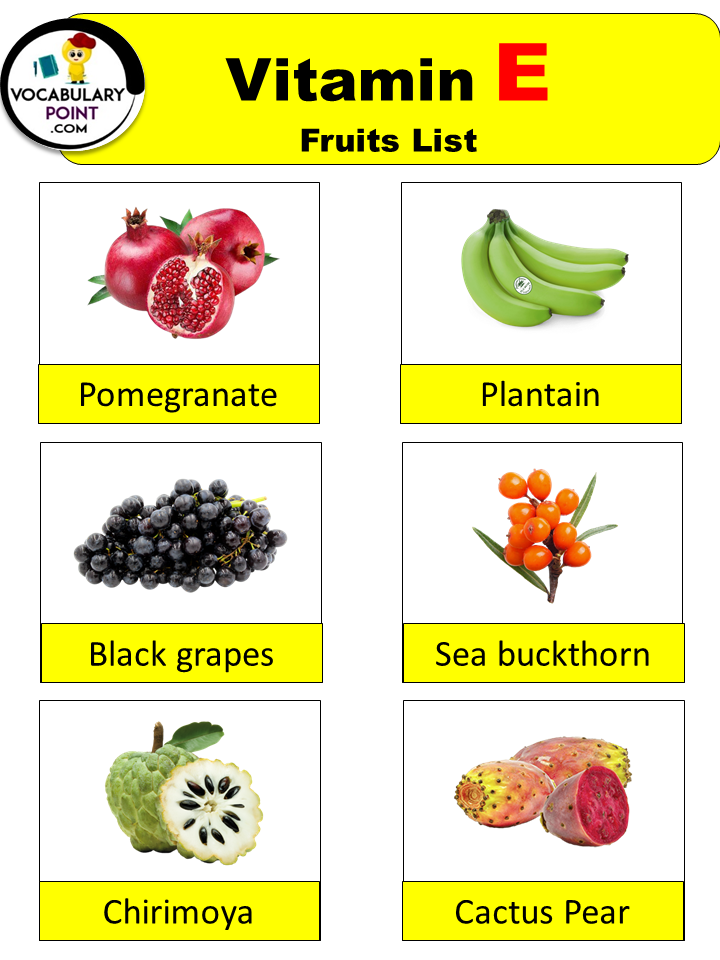
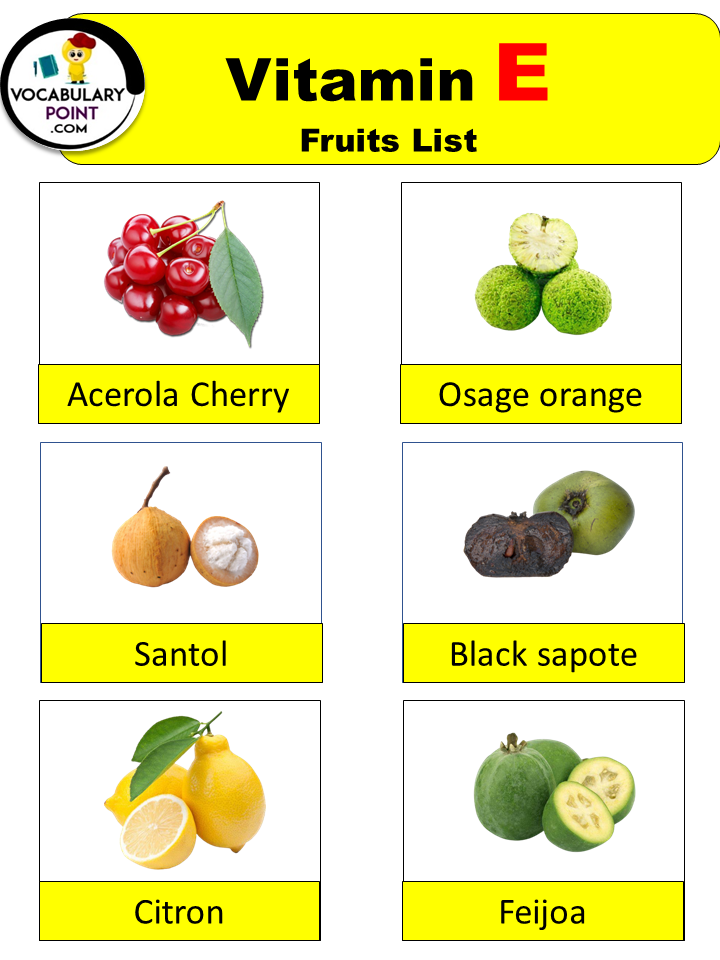
Fruits And Vegetables High In Vitamin E
Pomegranate
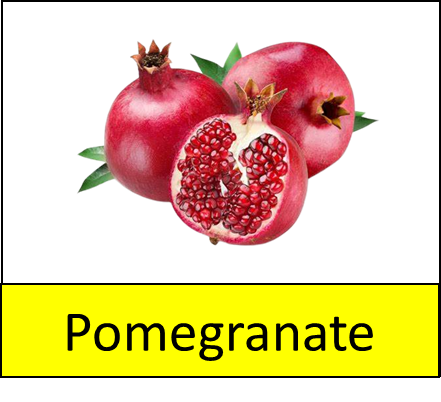
- Antioxidant Protection: Vitamin E is a powerful antioxidant that helps protect your cells from oxidative damage caused by free radicals. This protection can help reduce the risk of chronic diseases, including heart disease and cancer.
- Skin Health: Vitamin E is often used in skincare products due to its ability to nourish and protect the skin. It can help improve skin texture, reduce the signs of aging, and promote overall skin health.
- Immune Support: Vitamin E plays a role in maintaining a healthy immune system. It helps the body combat infections by supporting the proper functioning of immune cells.
Plantain
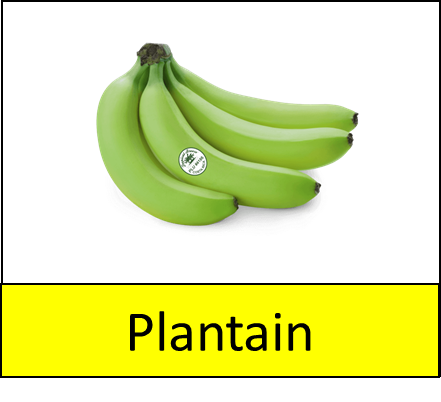
- Dietary Fiber Source:
Plantains are rich in dietary fiber, which aids digestion, promotes regular bowel movements, and supports a healthy gut.
- Vitamins and Minerals:
Plantains provide essential nutrients like vitamin A, vitamin C, and potassium, contributing to overall health and vitality.
- Energy Boost:
Plantains are a good source of complex carbohydrates, offering sustained energy and helping to fuel daily activities.
Black grapes
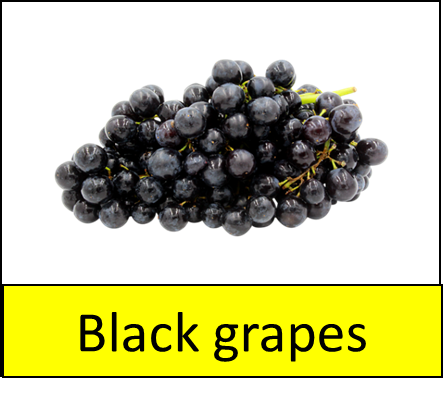
- Antioxidant Powerhouse:
Black grapes are abundant in antioxidants, like resveratrol, which can help protect cells from damage and support overall well-being.
- Heart Health Support:
Compounds in black grapes may contribute to heart health by promoting healthy blood pressure, improving circulation, and maintaining blood vessel function.
- Vitamin-Rich Fruit:
Black grapes contain essential vitamins like vitamin C and vitamin K, which play roles in immune function, wound healing, and bone health.
Sea buckthorn
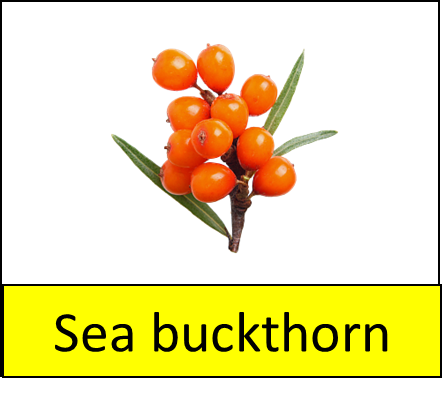
- Immune System Support:
Sea buckthorn is rich in vitamin C and antioxidants, which can help boost the immune system and protect the body against infections.
- Skin Health Enhancement:
The omega fatty acids and vitamins E in sea buckthorn can promote skin hydration, elasticity, and may help alleviate skin conditions.
- Digestive Health Aid:
Sea buckthorn’s dietary fiber content can aid digestion, support a healthy gut, and contribute to regular bowel movements.
Chirimoya
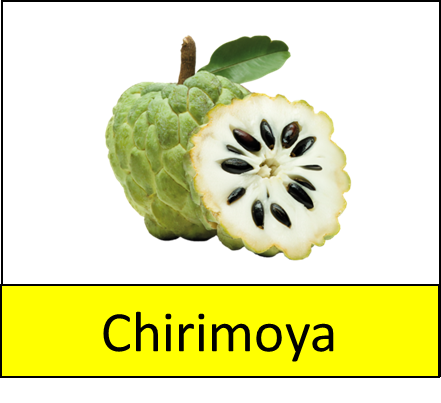
- Rich Nutritional Content:
Chirimoya is packed with essential nutrients like vitamin C, vitamin B6, and dietary fiber, contributing to overall health and well-being.
- Heart Health Support:
Chirimoya’s potassium content may help regulate blood pressure and support cardiovascular function.
- Digestive Aid:
The dietary fiber in chirimoya can aid digestion, promote regular bowel movements, and support a healthy gut environment.
Cactus Pear
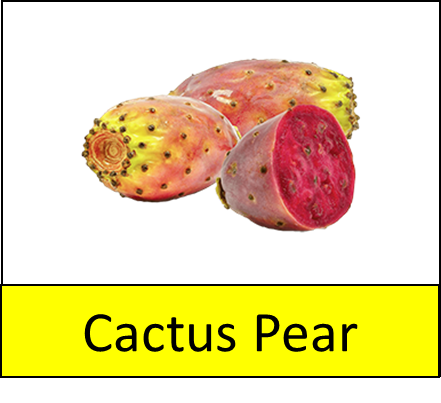
- Antioxidant Richness:
Cactus pear is a good source of antioxidants, such as vitamin C and flavonoids, which help combat oxidative stress and support overall health.
- Blood Sugar Management:
Cactus pear may help regulate blood sugar levels due to its fiber content and potential effects on insulin sensitivity.
- Digestive Support:
The dietary fiber in cactus pear can aid digestion, promote regular bowel movements, and contribute to a healthy gut environment.
Acerola Cherry
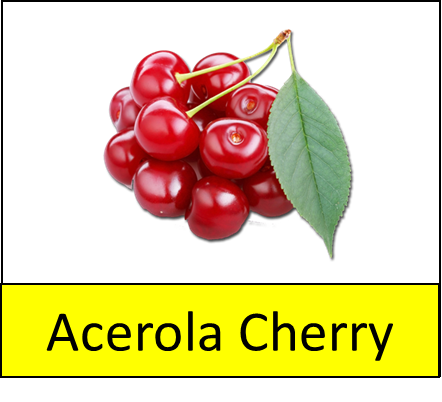
- Vitamin C Boost:
Acerola cherries are exceptionally high in vitamin C, which supports immune function, collagen synthesis, and overall health.
- Antioxidant Power:
The antioxidants in acerola cherries, including vitamin C and flavonoids, help protect cells from oxidative damage and support well-being.
- Skin Health Enhancement:
The vitamin C and other nutrients in acerola cherries contribute to skin health, aiding in collagen production and promoting a healthy complexion.Top of Form
Osage orange
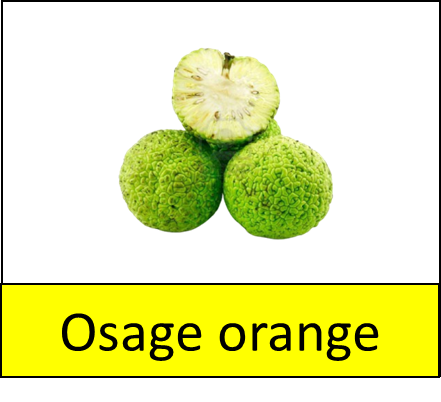
- Natural Pest Repellent:
Osage orange contains compounds that repel insects, making it useful for natural pest control in gardens and homes.
- Woodcraft and Crafts:
The durable wood of Osage orange is often used for woodworking projects and crafts due to its strength and vibrant color.
- Hedge and Windbreak Planting:
Osage orange trees are commonly planted as hedges and windbreaks, providing erosion control and wildlife habitat benefits.
Santol
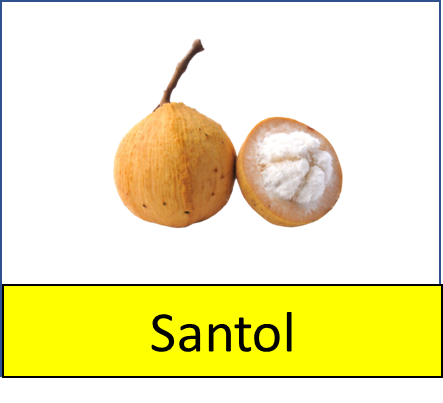
- Vitamin Richness:
Santol is packed with essential vitamins like vitamin C and vitamin E, contributing to immune support and overall health.
- Digestive Aid:
The dietary fiber found in santol can help promote healthy digestion, alleviate constipation, and support gut health.
- Antioxidant Properties:
Santol contains antioxidants that can help protect cells from oxidative stress and may contribute to reducing the risk of chronic diseases.
Black sapote
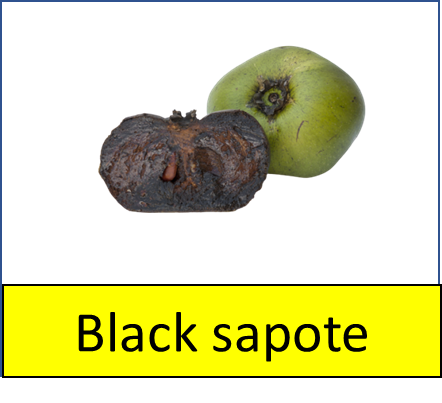
- Rich Nutritional Content:
Black sapote is packed with essential nutrients like vitamin C, fiber, and potassium, supporting overall health and well-being.
- Digestive Health Support:
The dietary fiber in black sapote can aid digestion, promote regular bowel movements, and contribute to a healthy gut.
- Heart Health Promotion:
Black sapote’s potassium content and low saturated fat content may help support cardiovascular health by regulating blood pressure and cholesterol levels.
Citron
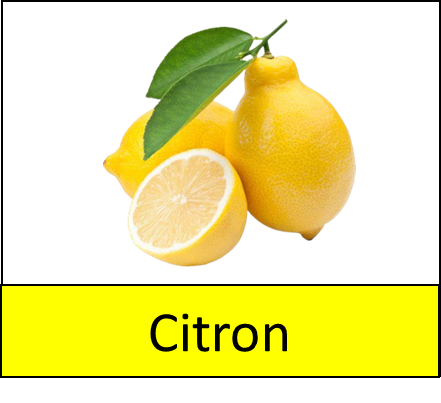
- Vitamin C Source:
Citron is rich in vitamin C, which supports immune function, collagen synthesis, and overall health.
- Digestive Aid:
The fiber content in citron can aid digestion, promote regular bowel movements, and support a healthy gut environment.
- Aromatherapy and Fragrance:
Citron’s aromatic properties make it useful for aromatherapy and as a natural fragrance in perfumes and cosmetics.
Feijoa
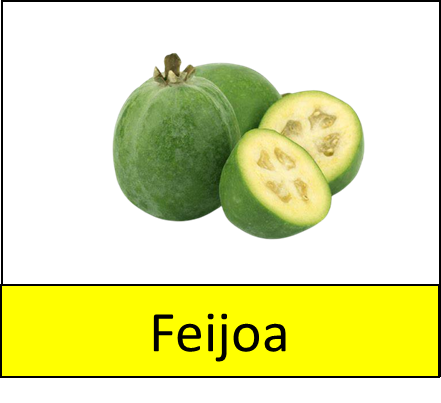
- Vitamin-Rich Fruit:
Feijoa is a good source of essential vitamins like vitamin C and vitamin B6, contributing to immune support and overall health.
- Dietary Fiber:
Feijoa contains dietary fiber that supports digestion, promotes regular bowel movements, and contributes to a healthy gut environment.
- Antioxidant Power:
Feijoa is rich in antioxidants, including vitamin C and flavonoids, which help protect cells from oxidative stress and support well-being.
